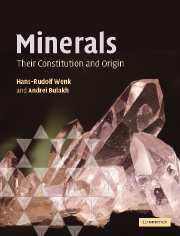Book contents
- Frontmatter
- Contents
- Preface
- Acknowledgments
- Figure credits
- Part I Structural features of minerals
- Part II Physical investigation of minerals
- Part III Variety of minerals and mineral-forming processes
- Part IV A systematic look at mineral groups
- 19 Important information about silica materials and feldspars
- 20 Simple compounds. Unusual mineral occurrences
- 21 Halides. Evaporite deposits
- 22 Carbonates and other minerals with triangular anion groups. Sedimentary origins
- 23 Phosphates, sulfates, and related minerals. Apatite as a biogenic mineral
- 24 Sulfides and related minerals. Hydrothermal processes
- 25 Oxides and hydroxides. Review of ionic crystals
- 26 Orthosilicates and ring silicates. Metamorphic mineral assemblages
- 27 Sheet silicates. Weathering of silicate rocks
- 28 Chain silicates. Discussion of some igneous and metamorphic processes
- 29 Framework silicates. Zeolites and ion exchange properties of minerals
- Part V Applied mineralogy
- Appendices
- Glossary
- References
- Index
- Plate section
- References
20 - Simple compounds. Unusual mineral occurrences
from Part IV - A systematic look at mineral groups
- Frontmatter
- Contents
- Preface
- Acknowledgments
- Figure credits
- Part I Structural features of minerals
- Part II Physical investigation of minerals
- Part III Variety of minerals and mineral-forming processes
- Part IV A systematic look at mineral groups
- 19 Important information about silica materials and feldspars
- 20 Simple compounds. Unusual mineral occurrences
- 21 Halides. Evaporite deposits
- 22 Carbonates and other minerals with triangular anion groups. Sedimentary origins
- 23 Phosphates, sulfates, and related minerals. Apatite as a biogenic mineral
- 24 Sulfides and related minerals. Hydrothermal processes
- 25 Oxides and hydroxides. Review of ionic crystals
- 26 Orthosilicates and ring silicates. Metamorphic mineral assemblages
- 27 Sheet silicates. Weathering of silicate rocks
- 28 Chain silicates. Discussion of some igneous and metamorphic processes
- 29 Framework silicates. Zeolites and ion exchange properties of minerals
- Part V Applied mineralogy
- Appendices
- Glossary
- References
- Index
- Plate section
- References
Summary
Introduction
After the discussion of some of the most common but also the most complex minerals in Chapter 19, we now examine some structurally and chemically very simple compounds that are rare and form only under unusual conditions. In this chapter we discuss minerals of native elements such as graphite (C), diamond (C), copper (Cu), gold (Au) and silver (Ag) and solid solutions of these elements (for instance, Au–Ag and Au–Cu) (Table 20.1). There are also intermetallic compounds with ordered crystal structures that differ from the end members. Often, these intermetallic compounds form during cooling as a result of ordering of high-temperature solid solutions of the same compositions. Some naturally occurring examples of intermetallics are awaruite (FeNi3), wairauite (FeCo), isoferroplatinum (cubic Pt3Fe), tetraferroplatinum (tetragonal PtFe), tulameenite (Pt2FeCu), ferronickelplatinum (Pt2NiFe), hongshiite (PtCu), rustenburgite (Pt3Sn), urvantsevite (PdBi2), auricuprite (Cu3Au), and schachnerite (AgHg). Don't be intimidated – no one will expect you to memorize these names and formulas. They are listed merely to give you an impression of the astonishing variety of intermetallic compounds.
Most of the minerals in this section are very rare. In total, they comprise less than 0.0002 weight% of the earth's crust, and many have been discovered very recently. However, not only are their structures interesting and well known in materials science, they are also of great economic interest. Native gold, platinum, osmium, iridium, and silver are the principal sources for these elements.
- Type
- Chapter
- Information
- MineralsTheir Constitution and Origin, pp. 337 - 346Publisher: Cambridge University PressPrint publication year: 2004



